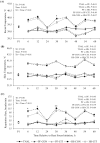Effects of supplemental citrulline on thermal and intestinal morphology parameters during heat stress and feed restriction in growing pigs
- PMID: 38812469
- PMCID: PMC11143481
- DOI: 10.1093/jas/skae120
Effects of supplemental citrulline on thermal and intestinal morphology parameters during heat stress and feed restriction in growing pigs
Abstract
Study objectives were to characterize the effects of citrulline (CIT) on physiological and intestinal morphology metrics during heat stress (HS) and feed restriction. Forty crossbred gilts (30 ± 2 kg body weight [BW]) were assigned to one of five treatments: (1) thermoneutral (TN) fed ad libitum (AL) with control (CON) supplement (TNAL; n = 8), (2) TN pair-fed (PF) with CON (PF-CON; n = 8), (3) TN PF with CIT (PF-CIT; n = 8), (4) HS AL with CON (HS-CON; n = 8), and (5) HS AL with CIT (HS-CIT; n = 8). During the period (P) 1 (7 d), pigs were in TN conditions (23.6 °C) and fed AL their respective supplemental treatments. During P2 (2.5 d), HS-CON and HS-CIT pigs were fed AL and exposed to cyclical HS (33.6 to 38.3 °C), while TNAL, PF-CON, and PF-CIT remained in TN and were fed either AL or PF to their HS counterparts. Citrulline (0.13 g/kg BW) was orally administered twice daily during P1 and P2. HS increased rectal temperature (Tr), skin temperature (Ts), and respiration rate (RR) relative to TN pigs (0.8 °C, 4.7 °C, and 47 breaths/min, respectively; P < 0.01). However, HS-CIT had decreased RR (7 breaths/min, P = 0.04) and a tendency for decreased Tr (0.1 °C, P = 0.07) relative to HS-CON pigs. During P2, HS pigs had decreased feed intake (22%; P < 0.01) and a tendency for decreased average daily gain (P = 0.08) relative to TNAL pigs, and by experimental design, PF pigs followed this same pattern. Circulating lipopolysaccharide-binding protein tended to be decreased (29%; P = 0.08) in PF relative to TNAL pigs and was increased (41%; P = 0.03) in HS compared to PF pigs. Jejunum villus height was decreased in PF relative to TNAL pigs (15%; P = 0.03); however, CIT supplementation improved this metric during feed restriction (16%; P = 0.10). Jejunum mucosal surface area decreased in PF (16%; P = 0.02) and tended to decrease in HS (11%; P = 0.10) compared to TNAL pigs. Ileum villus height and mucosal surface area decreased in HS compared to TNAL pigs (10 and 14%, respectively; P ≤ 0.04), but both parameters were rescued by CIT supplementation (P ≤ 0.08). Intestinal myeloperoxidase and goblet cell area remained similar among treatments and intestinal segments (P > 0.24). In summary, CIT supplementation slightly improved RR and Tr during HS. Feed restriction and HS differentially affected jejunum and ileum morphology and while CIT ameliorated some of these effects, the benefit appeared dependent on intestinal section and stressor type.
Keywords: intestinal health; mucosal surface area; pair-feeding.
Plain language summary
Heat stress (HS) negatively affects animal health and production efficiency and is a significant economic burden to global animal agriculture. Although the mechanisms responsible for reduced animal productivity during HS are complex and multifaceted, increasing evidence points to decreased intestinal barrier function as an important mediator of this response. Furthermore, HS causes a voluntary reduction in feed intake, and feed restriction independently induces gastrointestinal hyperpermeability. Loss of intestinal barrier integrity facilitates bacteria translocation across the epithelium into local and systemic circulation, thus initiating an immune response. Dietary citrulline has been shown to support gut health by improving intestinal barrier integrity and modulating intestinal inflammation. Therefore, the current study investigated the effects of citrulline supplementation on physiological and intestinal morphology parameters in heat-stressed and feed-restricted growing pigs. Herein, citrulline supplementation reduced respiration rate and rectal temperature in pigs exposed to the thermal load. Heat stress and feed restriction compromised small intestinal morphology, and while supplementing citrulline improved some of these parameters, the effects depended on the intestinal region and stressor type. Additional research is needed to evaluate the potential effects of citrulline supplementation on gut health during HS or nutrient restriction.
© The Author(s) 2024. Published by Oxford University Press on behalf of the American Society of Animal Science.
Conflict of interest statement
No conflicts of interest are declared by the authors.
Figures

References
-
- Abuajamieh, M., Kvidera S. K., Mayorga E. J., Kaiser A., Lei S., Seibert J. T., Horst E. A., Sanz Fernandez M. V., Ross J. W., Selsby J. T.,. et al.. 2018. The effect of recovery from heat stress on circulating bioenergetics and inflammatory biomarkers. J. Anim. Sci. 96:4599–4610. doi: 10.1093/jas/sky345 - DOI - PMC - PubMed
-
- Ananthakrishnan, M., Barr F. E., Summar M. L., Smith H. A., Kaplowitz M., Cunningham G., Magarik J., Zhang Y., and Fike C. D... 2009. L-Citrulline ameliorates chronic hypoxia-induced pulmonary hypertension in newborn piglets. Am. J. Physiol. Lung Cell. Mol. Physiol. 297:L506–L511. doi: 10.1152/ajplung.00017.2009 - DOI - PMC - PubMed
-
- Antunes, M. M., Leocádio P. C., Teixeira L. G., Leonel A. J., Cara D. C., Menezes G. B., Generoso Sde V., Cardoso V. N., Alvarez-Leite J. I., and Correia M. I... 2016. Pretreatment with L-citrulline positively affects the mucosal architecture and permeability of the small intestine in a murine mucositis model. J. Parenter. Enteral Nutr. 40:279–286. doi: 10.1177/0148607114567508 - DOI - PubMed
MeSH terms
Substances
LinkOut - more resources
Full Text Sources
Medical
Research Materials

